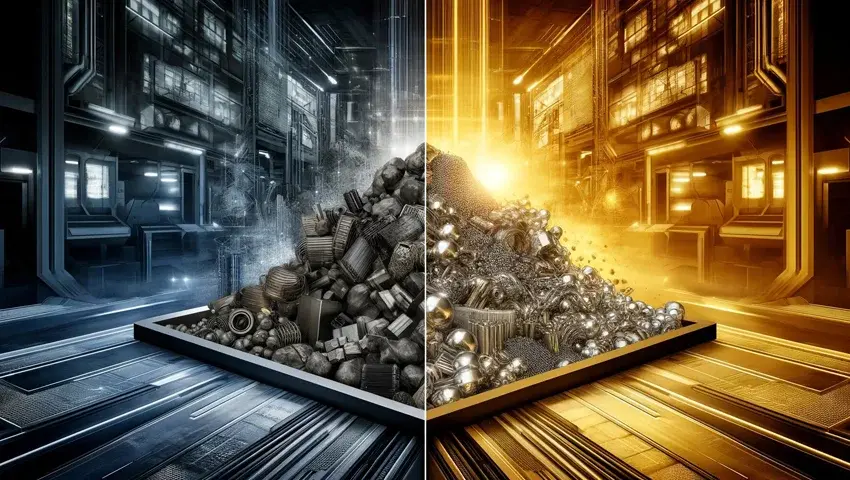
Black metal is a group of metals primarily composed of iron, derived from the Latin word "ferrum," meaning "iron."
These metals are valued across many industries for their impressive mechanical properties. Known for their strength and durability, as well as their ability to withstand high temperatures, black metals are the ideal choice in environments where high reliability is crucial. Additionally, due to their iron content, black metals possess magnetic properties.
Despite these advantages, black metals can rust and corrode when exposed to moisture and oxygen. To prevent this, they are often coated with protective layers or used in alloys that enhance their resistance to oxidation.
Their reliability and strength make black metals indispensable in sectors such as construction, automotive manufacturing, and machinery. These qualities play a pivotal role in the development of industries and infrastructure.
Colored metals are those that do not contain significant amounts of iron. This absence makes them non-magnetic, which distinguishes them in applications where magnetic properties could be detrimental.
Colored metals are crucial in fields such as electronics manufacturing, transportation, and construction. Their conductivity, lightweight, and corrosion resistance make them perfect for everything from microchips to airplanes.
At Mirada Levante, we specialize in the processing of non-iron metals like copper and aluminum, focusing on sustainable practices that enhance the lifecycle of these valuable resources. Our commitment to innovation in metal recycling positions us as a key player in the industry, contributing to environmental sustainability and advanced material solutions.
The differences between black and colored metals extend beyond their composition—black metals contain iron, while colored metals do not. Each type of metal possesses unique properties that make them ideal for specific applications. Here are the key distinctions:
1. Iron Content:
Black Metals: Comprise over 50% iron, which endows them with magnetic properties.
Colored Metals: Contain less than 50% iron, making them non-magnetic.
2. Magnetic Properties:
Black Metals: Are magnetic, making them valuable in electrical engineering and machinery manufacturing.
Colored Metals: Are non-magnetic, suiting applications where magnetism is undesirable.
3. Corrosion Susceptibility:
Black Metals: More prone to rust and corrosion, especially in moist environments.
Colored Metals: Have better corrosion resistance, ideal for use in high-moisture conditions.
4. Density and Weight:
Black Metals: Heavier and denser, useful in construction and industrial applications.
Colored Metals: Lighter and less dense, perfect for applications where reduced weight is crucial.
5. Strength and Conductivity:
Black Metals: Known for their strength and durability, used in critical structural applications.
Colored Metals: Excellent conductors of electricity and heat, indispensable in electrical engineering.
Colored metals have played a crucial role since the earliest stages of civilization. Copper, discovered as early as 5000 BCE, is considered one of the first metals used by humans, marking the transition from the Stone Age to the Copper Age. The subsequent invention of bronze, an alloy of copper and tin, initiated the Bronze Age. Metals such as lead and zinc were also used in ancient times for various purposes, including plumbing and cosmetics.
Despite its abundance in the Earth's crust, aluminum remained rare and difficult to extract until the 19th century. In 1825, Danish scientist Hans Christian Ørsted first produced aluminum under laboratory conditions, but it was not until the end of the 19th century that effective production methods were developed, making aluminum widely available for use.
As for black metals, they began to be actively used around 1200 BCE when iron came into widespread use, heralding the Iron Age. Iron, due to its availability and properties, played a key role in the development of various aspects of human activity, from construction to machinery manufacturing. Over time, its use became a foundation for the Industrial Revolution, which drastically changed the course of history.
Black metals include alloy steel, carbon steel, cast iron, and wrought iron. These metals are highly valued for their strength and durability, making them indispensable in many industrial fields. Carbon steel, also known as structural steel, plays a key role in construction, including in the world's largest skyscrapers and bridges.
These metals are widely used in the manufacture of transport containers, industrial pipelines, automobiles, and railway tracks, as well as in numerous commercial and household tools.
However, most black metals are prone to rust due to their high carbon content unless protected. Exceptions include wrought iron, which is resistant to rust due to its purity, and stainless steel, which is protected from corrosion by the addition of chromium.
The magnetic properties of black metals also prove useful in many applications, such as in engines and electronics. Even in everyday life, this property is handy, for example, when we attach a shopping list to a refrigerator door with a magnet.